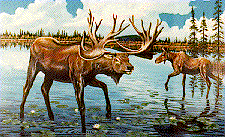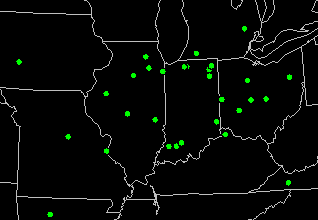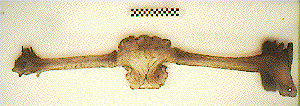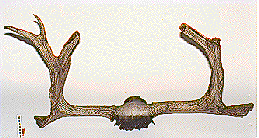

The stag-moose or elk (scientific name Cervalces scotti) is an extinct deer slightly larger than the modern moose. Its name, stag-moose, refers to the fact that it looks much like a cross between an elk and a moose. If you had been around to see one alive, you might have thought it looked like a stilt-legged moose with the face of an elk and very complex palmate antlers.
Palmate antlers are shaped like the palm of a hand, i.e. they have large flat areas and thinner projections. Modern moose (Alces alces) have palmate antlers; however, the stag-moose had more complex antlers than the modern moose.
The stag-moose is found in deposits that indicate it probably preferred mires and other wetlands environments such as spruce parklands. This habitat is similar to that preferred by modern moose. The stag-moose probably led a lifestyle very similar to that of the modern moose.

Although not extremely common, specimens of the stag-moose have been found in many midwestern states. This map shows some of the sites at which the stag-moose has been found in the midwestern United States. The sites on this map are all relatively well-dated and well-studied. These sites contain stag-moose remains that are between 40,000 and 11,500 years old.
Stag-moose went extinct approximately 11,500 years ago. Several dated specimens are in the collections of the Illinois State Museum. Among these a specimen from northern Illinois (on the left) and one from northern Indiana (on the right).

Many years ago this stag-moose skull with partial antlers was dredged up on the Biddle family farm. They did not know what it was but did recognize it as interesting. For years this skull hung on the wall of the barn. When ISM Curator of Geology Dr. Russell W. Graham identified it as an important stag-moose skull, the Biddle family generously donated it to the Illinois State Museum.

The cast on the right is of a skull that was dredged from a pond near Kendallville, Noble County, Indiana. It is one of the most complete known Cervalces skull. It shows the highly complex, palmate antlers that characterize the stag-moose. Radiocarbon dating indicates that this particular stag-moose lived about 13,500 years ago.
Illustration Credits: The drawing of the stag-moose (above left) is by Julianne Snider. The color image (above right) is a reproduction of a painting at the Illinois State Museum by P.R. Gulley Studios.